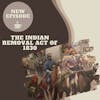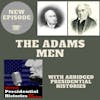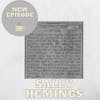The Bloody Island Massacre

After the murder of two white men in the Clear Lake region of California, the United States government responded by launching a campaign to exact revenge. This campaign came to be known as the Bloody Island Massacre. But what exactly happened?
Tune in this week to find out.
SOURCES
Garsha, Jeremiah J. (2015) "‘Reclamation Road’: A Microhistory of Massacre Memory in Clear Lake,California," Genocide Studies and Prevention: An International Journal: Vol. 9: Iss. 2: 61-75. (LINK)
“Horrible Slaughter of Indians.” San Francisco Daily Alta California. May 28, 1850: p. 2, col. 1. Courtesy of California Indian History. (LINK)
Khoka, Sasha and Suzie Racho. Marking a California Massacre - With a Native Ceremony of Forgiveness. KQED. May 15, 2020. (LINK)
“Bloody Island Massacre - Gold Chains: The Hidden History of Slavery in California.” ACLU - Northern California. (LINK)
“Bloody Island.” Five Views: An Ethnic Historic Site Survey for California (American Indians). National Park Service. November 17, 2004. (LINK)
Treaty of Guadalupe Hidalgo: February 2, 1848. Treaties and Conventions between the United States of America and Other Powers Since July 4, 1776. Government Printing Office, 1871, Washington, DC. Care of The Avalon Project, Yale University. (LINK)
“Lucy Moore Foundation seeks to create healing, understanding.” Lake County News. August 25, 2007. (LINK)
Gaye LeBaron, “Bloody Island” ‘Indian Massacre of Another Kind”, in The Press Democrat. 22 July 1990. Located in North Bay Digital Collections. Sonoma State University Library. (LINK)
Welcome to Civics and Coffee. My name is Alycia and I am a self-professed history nerd. Each week, I am going to chat about a topic on U.S history and give you both the highlights and occasionally break down some of the complexities in history; and share stories you may not remember learning in high school. All in the time it takes to enjoy a cup of coffee.
INTRO MUSIC
Hey everyone, welcome back.
Just north of the Robinson Rancheria Resort and Casino in northern California sits an unassuming plaque. Driving along Highway 20, motorists easily miss the marker dedicated in remembrance of one of the more shameful events in California history. However, if you are lucky enough to catch it, and pull over to review its message, the stone and metal memorial tells a devastating story.
Quote: “¼ mile west is the island called Bo-No-Po-Ti now Bloody Island. It was a place for Native gatherings until May 15, 1850. On that date, a regiment of the 1st dragoons of the U.S. calvary, commanded by Captain Nathaniel Lyon and Lieutenant J.W. Davidson, massacred nearly the entire native population of the island. Most were women and children. This act was in reprisal for the killing of Andrew Kelsey and Charles Stone who had long enslaved, brutalized, and starved indigenous people in the area. The island, now a hill surrounded by reclaimed land, remains a sacred testament to this sacrifice of innocents” end quote.
The plaque, dedicated in 2005, aims to both reframe the story previously told and serve as a place of memory for Pomo descendants. But what exactly happened?
This week, I am diving into the history of the Bloody Island Massacre. What was it? Who was involved? And why were two plaques erected in its memory?
Grab your cup of coffee, peeps. Let’s do this.
In the middle of the nineteenth century, California was dealing with a massive wave of migration as the result of a small thing called the gold rush. Men by the thousands descended upon the territory to strike it rich and lay their claims to the vast riches within the soil.
However, they weren’t alone. Much like the rest of the landmass that would come to be the United States, the California territory was home to thousands of indigenous Americans. Roughly three thousand members of the Pomo settled along the Clear Lake region and watched as their lands were slowly designated for settlement, forcing their relocation. And as was the case throughout the country, Anglo-Saxons and Europeans brought with them new diseases for which the Pomo had no natural immunity, severely impacting their overall membership.
In the aftermath of the Mexican-American war, indigenous Americans residing in the California territory found themselves in a politically odd situation. Before the conflict, they were considered Mexican citizens. Under the terms of the Treaty of Guadalupe Hidalgo, Mexican citizens' claims to property rights were to be honored, quote:
“In the said territories, property of every kind, now belonging to Mexicans not established there, shall be inviolably respected. The present owners, the heirs of these, and all Mexicans who may hereafter acquire said property by contract, shall enjoy with respect to it guarantees equally ample as if the same belonged to citizens of the United States,” end quote.
In addition to respecting their claims to property, the United States stipulated that Mexican citizens had one year to decide whether to retain their Mexican citizenship or become citizens of the United States. In theory, these same considerations and protections should have also been extended to the various tribal nations. However, no such protections or offers were extended. The United States continued to consider indigenous Americans as others, referring only to them as Indians and vowing to rescue any Mexican citizen who was captured by the quote-un-quote savage tribes.
Continuing the policy of treating native Americans as some sort of disease to be eradicated, the California legislature also enshrined statutes preventing indigenous Americans from things like testifying in court and denying them access to the franchise. In other words, the California territory was openly hostile to the various tribal nations who called the area home for generations.
In 1847, two men decided to try their hand at the American dream and bought a cattle ranch. Charles Stone and Andrew Kelsey, the same man for whom Kelseyville gets its name, purchased the property from a Mexican captain. Included in this bill of sale were several indigenous men, referred to as vaqueros, or cowboys. Stone and Kelsey were notoriously difficult, tough, and cruel cattle ranch owners. While the prior owner was absent for long stretches, giving a sense of autonomy to the men working the land, Stone and Kelsey were hands-on and lived on-site. As such, the Pomo were treated as slaves, with minimal rations, and were prohibited from securing their own food sources as they were barred from fishing and hunting on the land.
When news spread about gold in the waterways of Sacramento Stone and Kelsey dispatched several men to extract gold on their behalf. Unfortunately, the two men changed their minds about the endeavor and recalled the Pomo back to camp. But not before trying to turn a quick buck and selling off most of the provisions secured for the team. This meant the men were forced to make an over 100-mile trek without adequate food and water - leading to the deaths of almost the entire party.
While the inhumane treatment of indigenous Americans was nothing new, Stone and Kelsey were considered especially brutal. Not only did they fail to provide adequate provisions and demand nonstop exhausting labor, but they also exploited the men and women who worked their land. Women were treated as sex slaves and the men received severe beatings at the first sight of a complaint or request for better treatment. In one especially cruel example, Kelsey gave 100 lashes to a young man and, if that wasn’t harsh enough, finished the job by shooting him in the head. His crime? Well, sources differ. The young man either flirted with a young Pomo woman who Kelsey kept as a forced concubine or dared to ask Kelsey for more wheat to give to his dying mother. Regardless of the reason, the punishment hardly seems to fit the quote-unquote crime.
All of this mistreatment led to the Pomo rising up against their ensalvers. Whether in retaliation for the young man or from anger over the treatment of their women, several men attacked and killed Kelsey and Stone. One source I read indicated the deaths were a result of a failed rescue attempt of Pomo leader Augustine’s wife, but I was unable to find confirmation. Whatever the cause, two white men were killed at the hands of what many believed were savage Indians. And that couldn’t stand.
Upon hearing of the deaths, Kelsey’s brother Benjamin vowed revenge. He demanded the United States government respond, telling the military unit stationed in Sonoma that his brother was quote “killed in cold blood,” end quote. Unhappy with the pace of the military, Benjamin Kelsey organized a vigilante group and led a search for the men responsible for his brother’s death. They indiscriminately murdered dozens of indigenous Americans, none of whom had any role in the deaths of Stone and Kelsey. While they were eventually captured, no one was ever brought to trial.
Unwilling to allow the deaths of two white settlers go unpunished, the United States government responded quickly. The first dragoon division of the U.S. Calvary was deployed to Bo-No-Po-Ti to exact vengeance. Unsure of the conditions that awaited them, the unit decided on a sneak attack conducted under the cover of darkness to maximize their advantage. They estimated anywhere between 200 and 400 Pomo were stationed on the island and wanted to ensure maximum damage.
In reality, the individuals on the island at the time of the attack were mostly made up of women and children. And, if that wasn’t bad enough, those who were on the island had no ties to the murders of Stone and Kelsey. Under the command of Nathaniel Lyon, the military force invaded on May 15th, 1850 killing scores of Pomo. Casualty estimates vary anywhere from 60 to over 200; whatever the amount, most of the dead were not Pomo warriors - but the young women and children who inhabited the island.
News of the massacre was initially met with shock. Although many Californians had low opinions of the surrounding indigenous communities, the murder of women and children was a bridge too far. In reporting the story, the newspaper Alta California, not one to sympathize with native Americans, called the action a quote “horrible slaughter” end quote and was largely supportive of the Pomo, even pointing out how peaceful they were, writing partially quote: “little or no resistance was encountered, and the work of butchery was of short duration. The shrieks of the slaughtered victims died away, the roar of the muskets that ceased, and stretched lifeless upon the sod of their native valley were the bleeding bodies of these Indians,” end quote.
However this support didn’t last long and the paper issued a retraction just a few days later, citing testimony from General Persifor F. Smith. The shift in narrative stood for decades, even making it to a marker dedicated to its memory in the mid-twentieth century. The plaque was sponsored by the Native Sons of the Golden West. The fraternal organization was initially established in 1875 with a focus on preserving California's history. Unfortunately, the history they preserved was not always an accurate reflection of events, exemplified by the marker dedicated in 1942 which reads quote:
“Scene of a battle between U.S. soldier under the command of Captain Lyons and Indians under Chief Augustine, April 14th, 1850. Dedicated as a historical monument by the native sons of the Golden West, May 20th, 1942,” end quote. Not only do they have the date of the incursion incorrect, but the word choice also paints a vastly different picture from actual events.
One woman, known as Lucy Moore, managed to survive the attack as a little girl. In Moore's telling of the events, she hid under the water, using a hollowed-out reed as a breathing apparatus until she was far enough away from the calvary. Living to the age of 110, Moore shared her memories of the harrowing attack with her descendants. This included her great-grandson Clayton Duncan who established the Lucy Moore foundation in her memory in 2000. The foundation has focused both on correcting the inaccurate history of the events in 1850 and establishing a cultural center for the tribe. In 2005, the foundation successfully sponsored a new dedication, putting the events of the massacre into sharper focus.
Every year, Clayton organizes a Sunrise Ceremony of Forgiveness to pay tribute to those who lost their lives during the attack. The foundation hopes to increase awareness about the massacre and educate residents about the events at Bloody Island. They are also working to preserve the site of the mass graves. Their goal is to secure the area as one of archaeological sensitivity and prevent any development of the land.
Considered one of the best-documented indigenous massacres in California history, Bloody Island is just one in a long line of questionable acts perpetrated by American settlers. Much like the rest of the United States, indigenous communities in the California territory were seen and treated as savages incapable of cultivating the vast natural resources at their fingertips. They were barriers to be cleared in the pursuit of land, riches, and power. Adding to this insult is the pervasive reframing of the historical narrative to minimize, and sometimes outright omit, the experiences of these communities.
One small silver lining is historians have begun to interrogate these events with a new lens which focuses on the perspective of previously marginalized individuals such as the Pomo. This helps fill in the gaps and, in my opinion, provides a more complete narrative of the past.
Thanks, peeps. I’ll see you next week.
Thanks for tuning and I hope you enjoyed this episode of Civics & Coffee. If you want to hear more small snippets from american history, be sure to subscribe wherever you get your podcasts. Thanks for listening and I look forward to our next cup of coffee together.
OUTRO MUSIC
Listener Favorites
Not sure where to begin? Take a listen to some fan favorites.

























